The Art of Freestyle Rap Instrumental Beats


Intro
The evolution of freestyle rap instrumental beats is a fascinating journey that has shaped the landscape of hip-hop music. Freestyle rap, characterized by its spontaneous flow and lyrical improvisation, relies heavily on these instrumental tracks to provide a canvas for artists' creativity. Understanding the history, production techniques, and the elements that constitute these beats is crucial for anyone interested in hip-hop. Moreover, the impact of technological advancements on the development of freestyle beats cannot be underestimated. This article seeks to uncover the many layers that form the foundation of freestyle rap instrumental beats, guiding music enthusiasts, aspiring musicians, and students through this compelling genre.
Artist Profile
Biography and Background
Freestyle rap has roots deeply embedded in the culture of hip-hop. While many influential artists have contributed to this genre, it is essential to explore individual profiles to comprehend the broader influences at play. Artists like Eminem, Black Thought, and Big L are just a few examples of musicians who have excelled in freestyle rap, using instrumental beats to showcase their lyrical dexterity.
Eminem, born Marshall Mathers, emerged from Detroit's underground scene in the late 1990s. His ability to improvise verses quickly set him apart, often leading to head-to-head freestyle battles. Similarly, Black Thought, the lead MC of The Roots, has a reputation for intricate lyricism, often crafting immediate verses over various instrumentals during live performances. Each artist's background contributes to their unique style, which deserves deeper examination.
Major Influences and Inspirations
Freestyle rap artists draw influences from various sources. These include other genres, cultural experiences, and personal narratives. Eminem found inspiration in the works of rappers like Nas and Rakim. He also acknowledges the effect of pop culture and personal struggles in shaping his lyrical approach. In the case of Black Thought, jazz, funk, and soul play significant roles. The incorporation of these styles into their instrumental beats creates a rich sonic backdrop, fostering a vibrant rap environment.
Song Analysis
Theme and Lyrics Breakdown
The themes present in freestyle rap often oscillate between personal experiences and broader societal issues. A close look at tracks by artists provides insight into this dynamic. Lyrically, these pieces frequently address topics such as resilience, socio-political commentary, and personal growth. The use of instrumental beats enhances the emotional weight of these themes, allowing artists to convey messages more powerfully.
For instance, Eminem's "Lose Yourself" combines introspective lyrics with a strong, engaging instrumental, encouraging listeners to relate to the struggle he portrays.
Instrumentation and Composition
Freestyle rap instrumental beats typically include components such as drum patterns, bass lines, and melodic hooks. These elements combine to create an inviting environment for improvisational flow. The selection of samples, whether from jazz records or classic hip-hop tracks, shapes the overall sound. Modern producers employ digital tools such as Ableton Live and FL Studio to craft intricate beats and capture the spontaneity that characterizes freestyle rap.
Instrumental variations can significantly impact the mood of the performance. Beats with heavy bass create a commanding presence, while softer melodies can evoke introspection.
Freestyle rap flourishes within a diverse range of instrumental frameworks, illustrating its adaptability and creativity.
Different artists exhibit unique preferences in their choices of beats, seen in their signature styles. Some favor heavy, aggressive beats, while others lean towards smooth, melodic instrumentals, allowing for nuanced lyricism. The correlation between the chosen instrumentals and the artist's message deserves continued attention in the study of freestyle rap.
Through every analysis, the intricate relationship between instrumental beats and lyrical flow becomes increasingly clear, revealing the depth of the artistry involved in freestyle rap.
Foreword to Freestyle Rap Instrumental Beats
Freestyle rap instrumental beats serve as the backbone of the freestyle rap genre. These beats are not simply background music; they define the structure and flow that artists utilize during performances. They play an important role in both live and recorded settings, providing a canvas upon which improvisation occurs. Without a solid instrumental, the essence of freestyle rap can be diminished, making the understanding of these beats crucial for any aspiring artist or enthusiast.
Importance of Instrumental Beats
Understanding instrumental beats is essential for multiple reasons. First, they unlock the ‘freestyle’ aspect of rap. Freestyle relies on the ability to think spontaneously, allowing artists to create lyrics and rhythms in real time. The right instrumental can elevate this process, enabling rappers to showcase their creativity and skill. They also set the mood, influencing the emotional tone of the performance.
Moreover, these beats allow for distinct stylistic expressions. Freestyle rap is characterized by various sub-genres and cultural influences. Instrumental beats differ based on regional styles, from the grimy beats of East Coast hip-hop to the laid-back rhythms of West Coast G-funk. This diversity in beat production offers artists the freedom to explore and define their own sound.
Consideration for Artists
For artists, selecting an instrumental is often as crucial as the lyrics themselves. The beats must resonate with the artist's personal style and message. Producers like J Dilla and DJ Premier have mastered the craft of creating beats that enhance lyrical content, showing how vital it is to choose wisely. Additionally, understanding the components of instrumental beats can provide artists with the knowledge to create their own tracks.
"The beat is the foundation. What you say on top harmonizes with it. Choose wisely."
Historical Context
Understanding the historical context of freestyle rap instrumental beats is essential for appreciating their significance in modern music. This section will illuminate how these beats emerged, developed, and transformed over decades. The historical backdrop lays a foundation for recognizing not only the artistry involved but also the cultural implications associated with this genre.
Origins of Freestyle Rap
Freestyle rap has its roots in the late 1970s, where early hip-hop culture began to take shape in the Bronx, New York. DJs played a pivotal role by using turntables to mix records, creating a lively atmosphere at parties. It was during these gatherings that MCs would often showcase their improvisational skills. This marked the beginning of freestyle rap, which is characterized by spontaneous lyricism and delivery.
Initially, these sessions were informal, embodying a communication form among peers. This art form encouraged creativity, allowing rappers to respond to each other in real-time. The performances were not structured, which gave rise to authentic expressions of personality and ideas.
As hip-hop gained popularity throughout the 1980s, the freestyle became a competitive practice. Events, known as battles, were held, demanding a higher level of skill and artistry. This period also saw the Miami bass and electro influences enter the scene, which expanded the instrumental soundscape for freestyle rap.
Evolution of Instrumental Beats
The evolution of instrumental beats has profoundly influenced freestyle rap. In the early days, instrumentals often came from disco, funk, and soul records, creating a rich tapestry for musicians to draw upon. As rap progressed into the 1990s, producers like DJ Premier and Pete Rock began to craft unique beats specifically for hip-hop. The introduction of samplers allowed for more intricate layers and textures in the music, which enriched the freestyle experience.
With advancements in technology, the 2000s saw a significant shift in beat production. Digital Audio Workstations (DAWs) became the norm for producers, democratizing beat-making. This accessibility encouraged a larger number of aspiring artists to experiment with freestyle rap. Additionally, the rise of the internet and platforms like SoundCloud allowed creators to share their beats worldwide.
Over time, there has been a blending of genres, where elements of electronic music and even rock began to infiltrate hip-hop instrumentals. This evolution reflects societal changes and technological advancements, further enhancing the freestyle experience. As the musical landscape continues to shift, freestyle rap remains a vital form of cultural expression, deeply anchored in its history.
Understanding Freestyle Rap
Understanding freestyle rap is essential for grasping the nuances of its instrumental beats. Freestyle rap is not just a form of musical expression; it embodies the improvisational spirit of hip-hop culture. By recognizing its elements, fans and aspiring musicians can better appreciate the energy and creativity involved in this genre.
Definition and Characteristics
Freestyle rap typically refers to impromptu lyrical flow that artists produce without pre-composed lyrics. It emphasizes spontaneity, allowing rappers to express thoughts and emotions on the spot. Here are some key characteristics:
- Improvisation: The heart of freestyle rap lies in its improvised nature. Rappers build verses based on real-time stimuli.
- Rhythm and Flow: Successful freestylers exhibit a firm grasp of rhythm. Their ability to create engaging patterns and maintain a smooth flow is critical.
- Wordplay and Rhyme Schemes: Clever wordplay enriches the content. Advanced rhyme schemes can enhance the delivery, making it more captivating.
- Cultural References: Many freestyles incorporate current events or popular culture, showcasing the artist's wit and relatability.
These elements demonstrate the depth and complexity involved in freestyle rap. It challenges artists to be quick thinkers, which fosters a richer connection with the audience.
Culture and Community
The culture surrounding freestyle rap fosters a unique community. It is a space where individuals come together to appreciate and participate in the art form. Understanding this culture involves acknowledging several core aspects:
- Open Mic Events: Chances to perform and get feedback are crucial. These gatherings allow aspiring rappers to showcase their skills and grow.
- Collaboration: Many artists find inspiration in each other. The collaborative environment encourages skills sharing and personal development.
- Competition: Freestyle battles create a competitive yet supportive atmosphere. These events motivate artists to refine their craft while engaging with peers.
This community atmosphere shapes an artist's growth and style. When passionate individuals come together, the freestyle rap scene thrives, pushing the boundaries of creativity.
"Freestyle rap is a mirror that reflects not just the artist's mind but the pulse of the community around them."
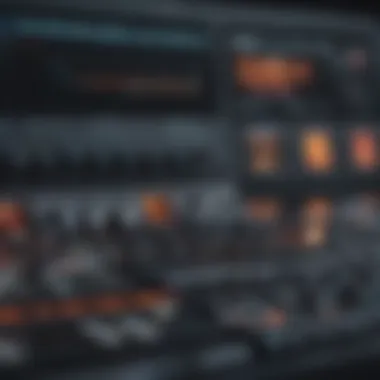
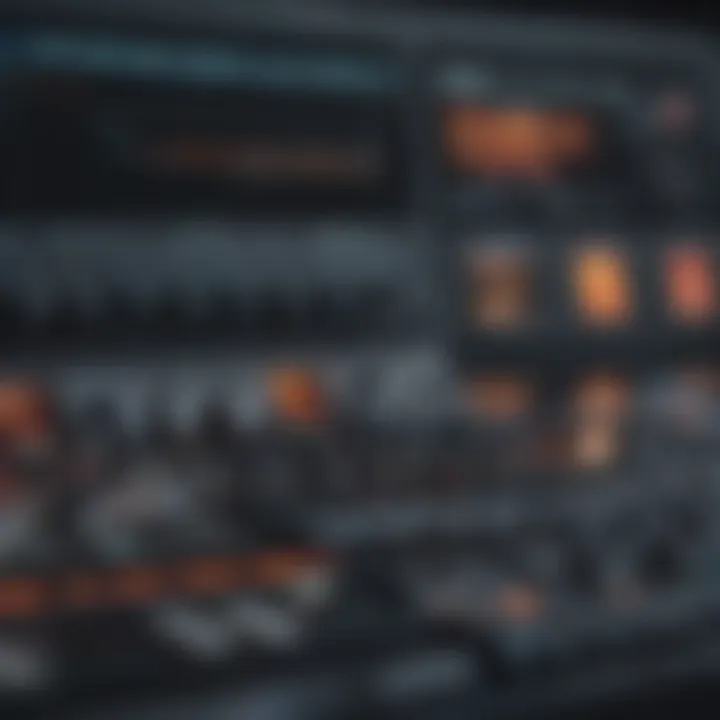
A deep understanding of freestyle rap enhances appreciation for the intricacies of instrumental beats and the broader rap culture.
Components of Instrumental Beats
The components of instrumental beats are crucial for understanding the framework that supports freestyle rap. These elements not only shape the sound but also enhance the overall experience for both artists and listeners. By examining the essential components—including rhythm and tempo, melodic structure, and sampling techniques—one can appreciate the technical artistry required to create compelling soundscapes that encourage improvisation. Each of these aspects contributes uniquely to the character of freestyle raps, influencing performance and reception.
Rhythm and Tempo
Rhythm and tempo are the backbone of any beat. They establish the pacing and energy of the track. In freestyle rap, the rhythm dictates how an artist will flow over the instrumental. A faster tempo can evoke excitement and urgency, while a slower tempo may allow for more introspective and nuanced lyricism.
Understanding time signatures is important when crafting resulting beats. Most rap beats can be found in a 4/4 time signature, which offers a familiar foundation for artists. However, variations can introduce interesting complexities. The use of syncopation can also add depth, making the rhythm less predictable yet engaging for the audience.
"A well-crafted rhythm keeps the flow dynamic, allowing freestylers to explore spontaneous thoughts and ideas."
Melodic Structure
Melodic structure refers to the arrangement of notes and chords that make up the instrumental. It creates the mood and adds emotional depth to the beat. In freestyle rap, melody plays a key role in complementing the lyrics. A simple or minimalistic melodic line can provide a solid base, allowing the rapper's vocals to stand out. Alternatively, more intricate melodies might introduce an element of challenge for the freestyler, pushing them to elevate their lyrical content.
Using varied melodies can also enhance the listener's experience. For instance, repetition can create familiarity, while new melodic content keeps the audience engaged. Additionally, the key of the instrumental can affect the overall feel of the piece, impacting the delivery and emotional resonance of the rap.
Sampling Techniques
Sampling is a defining characteristic of many instrumental beats. This technique involves taking snippets of existing music and recontextualizing them within a new composition. Sampling allows producers to pay homage to past artists while creating something fresh. Not only does this enhance creativity, but it also connects different musical eras and genres, fostering a sense of continuity in the music scene.
There are various approaches to sampling. Some producers prefer recognizable hooks to capture listener interest while others might choose obscure tracks to create niche appeal. However, it's essential to consider copyright laws and seek permission where necessary. The balance between creativity and legality is crucial for any aspiring producer.
In summary, the components of instrumental beats significantly shape the environment for freestyle rap. By understanding rhythm and tempo, melodic structure, and sampling techniques, artists can harness these elements to enhance their improvisational skills and ultimately create more impactful performances.
Production Techniques
Production techniques form the backbone of freestyle rap instrumental beats. They define not only the sound but also the mood and energy of a track. Understanding these techniques can empower both producers and artists, offering them tools to craft compelling pieces. This section will explore the essential software, tools, and strategies producers can utilize to enhance their work.
Software and Tools
The digital landscape has transformed how music is created. Software is central in shaping the sound of freestyle rap instrumental beats. Some of the most widely used software includes:
- Ableton Live: Known for its intuitive interface and real-time capabilities. It’s ideal for improvisation and live performance.
- FL Studio: Renowned for its easy-to-use step sequencer, it allows producers to create intricate beats quickly.
- Logic Pro: Offers a comprehensive suite of features suitable for both beginners and advanced users.
Tools such as MIDI controllers and audio interfaces are also vital. They provide hands-on control over sounds and recording, influencing how beats are arranged. The choice of software can significantly affect the quality and characteristics of the final output.
Creating Unique Sounds
Creating unique sounds is essential in distinguishing one’s music in a saturated market. Techniques to achieve originality include:
- Layering Sounds: Combining multiple samples can create a richer soundscape. This may involve stacking various drum sounds or melodies.
- Effect Processing: Utilizing effects like reverb, chorus, and delay can transform a basic sound into something distinctive.
- Field Recordings: Incorporating real-world sounds introduces an authentic element to beats. This can range from natural sounds to urban noise.
Producers often experiment with these techniques to develop their style. This creative freedom is fundamental in both crafting instrumentals and supporting freestyle rap artists during improvisation sessions.
"The essence of production lies in experimentation and the continuous pursuit of innovation."
Role of Technology in Beat Creation
The integration of technology in beat creation has fundamentally transformed the landscape of freestyle rap. This evolution not only enhances the creative process but also broadens the possibilities for aspiring musicians. Technology influences various aspects of producing instrumental beats, from accessibility to complexity in sound design.
Producers today leverage an array of technological tools, which allow for a diverse range of beats that cater to different styles and preferences. These advancements have made it easier than ever for artists and producers to experiment with sounds, thus fostering innovation within the genre. The importance of technology in agility, sound experimentation, and collaboration cannot be understated.
"Technology is an enabler that empowers artists to push the boundaries of their creativity."
Digital Audio Workstations
Digital Audio Workstations, commonly referred to as DAWs, are at the heart of modern music production. Programs like Ableton Live, FL Studio, and Pro Tools facilitate the entire beat-making process. They provide musicians with a platform to arrange, edit, and mix their tracks all in one place, making them essential for anyone looking to produce freestyle rap instrumentals.
The versatility of DAWs supports the use of multiple tracks, enabling users to layer various sounds, vocals, and effects seamlessly. This functionality allows producers to create rich, textured beats that support complex rap flows. Moreover, many DAWs offer built-in libraries of samples and loops, which expand the available toolkit for artists and make the process more efficient.
Virtual Instruments
Virtual instruments play a significant role in beat creation as well. These software-based counterparts of traditional instruments bring a vast array of sounds to producers’ fingertips. Various plugins, such as Native Instruments’ Kontakt or Spectrasonics’ Omnisphere, provide high-quality sampled sounds that can emulate everything from orchestral strings to synthetic leads.
The main advantage is the ability to customize sounds without the need for physical instruments. Each sound can be tweaked in real-time, allowing for unique variations that result in personalized compositions. Artists can integrate these virtual instruments directly into their DAWs, ensuring a smooth workflow and quick access to a myriad of sonic possibilities.
Freestyle Techniques and Strategies
Freestyle techniques and strategies are vital for any serious artist in the world of rap. They represent the foundation for effective improvisation and expression. Understanding these techniques can significantly enhance a rapper's ability to connect with their audience and communicate thoughts and feelings through rhythm and rhyme. Furthermore, these skills can attract attention in a competitive environment and lead to collaborations that push creative boundaries.
Improvisational Skills
Improvisational skills are at the core of freestyle rap. Being able to think quickly is essential. Rappers often have to come up with rhymes or phrases on the spot. This skill set helps them adapt to the beat and the vibe of the audience. It allows for spontaneity and authenticity in performances. A strong improvisational rapper can create compelling narratives using real-time experiences, emotions, and observations.
Some techniques to improve improvisational skills include:
- Word Association: This technique involves rapidly connecting words and phrases to build bars.
- Practice with Prompts: Using random words or themes can stimulate creativity during practice.
- Listening and Responding: Engaging with the music and other performers in real-time hones the ability to respond swiftly.
Improvisational skills not only enrich the performance but also build confidence. Many successful rappers started honing these abilities in informal settings like cyphers and open mics.
Building a Flow
Building a flow is another cornerstone of successful freestyle rap. Flow refers to the rhythm and patterns that fit with the beat. It influences how a rapper delivers their lyrics. The right flow can elevate lyrics' impact, making them catchy and memorable. Without a clear flow, even the most clever lyrics can fall flat.
There are various approaches to developing a solid flow:
- Studying Different Artists: Listening to various freestyle rappers can provide insights into different flow approaches.
- Breath Control: Good breath control helps sustain longer verses and maintain clarity.
- Experimenting with Different Beats: Trying out flows over different instrumental styles can help refine versatility.
Ultimately, developing a flow is about personal expression. Each rapper's unique style contributes to the diversity of freestyle rap.
Building a flow involves rhythm, clarity, and emotional engagement. When perfected, it becomes a powerful tool for every freestyle rapper.
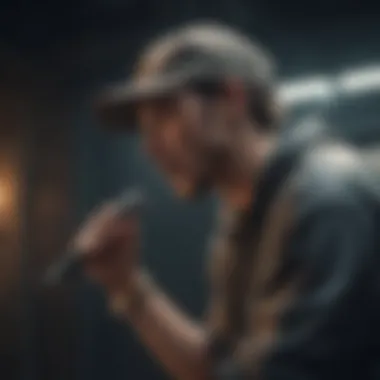

Cultural Impact of Freestyle Beats
Freestyle rap instrumental beats play a crucial role in the cultural landscape of hip-hop. They serve not just as the backdrop for lyrical improvisation but also as an expression of creativity and individuality. The cultural impact of these beats can be seen in various dimensions, influencing artists, audiences, and the broader music scene.
One significant element is how these beats shape an artist's identity. For many rappers, the choice of instrumental can reflect personal style, cultural background, and artistic vision. Beats are not merely tools; they are components that artists utilize to communicate their narratives. Freestyle sessions provide a platform for experimentation, allowing artists to deliver raw and unfiltered versions of their thoughts and emotions. The spontaneity inherent in freestyle rap often leads to unforgettable performances that resonate deeply with listeners.
Additionally, freestyle beats promote a strong community spirit within hip-hop culture. Sharing beats and collaborating during freestyle sessions fosters a sense of belonging among participants. This communal aspect encourages artists to build relationships and exchange ideas, resulting in artistic growth and innovation.
The significance of freestyle beats also extends to audiences. They create an interactive experience, inviting listeners to engage not only with the music but with the lyrical content as well. The dynamic nature of freestyling captivates fans, making them feel part of the performance. As artists rap in real time, audiences witness the creative process unfold, which enhances their connection to the music.
Lastly, freestyle rap instrumental beats contribute to the ongoing evolution of the genre. As new styles and influences emerge, beats adapt, providing a sonic foundation for different expressions. This adaptability allows hip-hop to remain relevant in an ever-changing musical landscape.
"Freestyle rap is a celebration of creativity, showcasing the power of words set to beats that inspire improvisation and connection."
In summary, the cultural impact of freestyle beats is profound. They influence artistic development, foster community, engage audiences, and drive the evolution of hip-hop. Understanding this impact is essential for appreciating not only the music itself but also the rich cultural narrative it represents.
Influence on Artists
Freestyle beats profoundly shape the identities and careers of artists. By selecting specific instrumentals, artists communicate their unique styles and narratives. The process of freestyling encourages spontaneity, allowing rappers to express their thoughts freely. This mode of expression contributes to their artistic development and personal growth. Artists often find themselves discovering new aspects of their craft during freestyle sessions, which may lead to breakthroughs in their songwriting or performance styles.
Furthermore, freestyle rap often serves as a platform for collaboration. Many artists engage in freestyling with peers, leading to shared experiences and mutual inspiration. This collaborative spirit bolsters creativity and generates fresh ideas, pushing artists to explore new directions in their work. Over time, such influences culminate in the emergence of distinct sub-genres and styles, further enriching hip-hop.
Reception by Audiences
The reception of freestyle rap by audiences highlights its communal nature. Fans of freestyle appreciate the authenticity and rawness that come with unprepared performances. The element of surprise captivates listeners, as they anticipate how an artist will weave words in real-time with the given instrumental. Audience interaction enhances the experience, often leading to memorable moments in performances.
Moreover, audiences may connect to the themes and stories expressed in freestyle rap. The lyrics often reflect genuine emotions and experiences. This connection deepens the listeners' appreciation, making them more invested in the artist's journey.
As a result, freestyle rap serves not only as a musical experience but also as a shared cultural moment, reflecting the collective voice of the community. Through audience responses and participation, freestyle rap solidifies its role in shaping hip-hop culture.
Challenges in Freestyle Rap Production
The creation of freestyle rap instrumental beats involves various challenges that can influence the overall output of an artist. Understanding these challenges is vital for aspiring musicians and freestyle artists alike. It allows them to anticipate difficulties and develop strategies to overcome them. Moreover, knowing these obstacles can enhance one's creative expression and improve artistic skills.
Freestyle rap is inherently spontaneous. This spontaneity often leads to performance anxiety. Artists want to deliver content that is not only engaging but also impressive. The pressure to perform can be overwhelming, especially in competitive environments. Confronting performance anxiety can foster personal growth and artistic development.
Overcoming Performance Anxiety
Performance anxiety is a common issue for many artists. It can manifest as fear of judgment, worry about forgetting lines, or anxiety over failing to connect with the audience. For freestyle rappers, this can be particularly pronounced because their art form relies on improvisation and quick thinking.
To overcome this challenge, several strategies can be employed:
- Practice Regularly: Frequent engagement with freestyle rapping helps sharpen skills and build confidence.
- Familiarize with the Environment: Visiting the performance space beforehand can reduce anxiety, making the artist more comfortable.
- Focus on Breathing: Techniques like deep breathing can help calm nerves and center the mind.
- Visualize Success: Imagining a successful performance can significantly boost confidence levels.
By addressing performance anxiety, artists can unleash their creativity and deliver compelling and authentic performances. Effective management of this anxiety leads to improved flow and better engagement with the audience.
Navigating Creative Blocks
Creative blocks are another significant challenge in freestyle rap production. These blocks can occur when an artist feels stuck or unable to generate new ideas. They often lead to frustration and can hinder growth. Identifying ways to navigate these creative barriers is essential for continued artistic development.
Some approaches include:
- Taking Breaks: Sometimes stepping away from the project allows for fresh perspectives.
- Collaborative Work: Collaborating with other artists can inspire new ideas and rekindle the creative spirit.
- Experiment with Different Beats: Changing the instrumental backdrop can unlock new avenues of creativity.
- Journaling: Recording thoughts or experiences can serve as a source of inspiration in the future.
Overcoming creative blocks empowers freestyle rappers to express their thoughts more freely and energetically. It encourages an environment where ideas flow, enabling artists to push boundaries and explore various themes in their work.
"The greatest enemy of creativity is self-doubt." — Sylvia Plath
Each challenge in freestyle rap production offers valuable lessons. By addressing performance anxiety and navigating creative blocks, artists can create more significant works that resonate with their audiences. This journey of overcoming obstacles is crucial for both personal growth and artistic expression.
Notable Freestyle Instrumental Producers
Freestyle rap instrumental producers play an important role in the development and execution of this art form. Their contributions are crucial in shaping the soundscapes that artists use for spontaneous creativity. These producers create beats that not only inspire freestyle rapping but also push the boundaries of musical innovation.
The scene is vast, with different styles and influences melding into unique sounds. Producers often work behind the scenes, yet their impact is felt prominently in the rap community. They provide the rhythmic foundation that allows artists to explore their lyrical skills. The variety of instrumental beats influences the flow and style of freestyle performances.
Additionally, successful collaboration between artists and producers can elevate the quality of performances. Producers understand the nuances of freestyle rap. They craft beats that encourage improvisation, combining elements from various genres such as jazz, funk, and electronic music. This diversity can lead to richer lyrical performances and enhance the overall experience for both artists and audiences.
Key Figures in the Scene
Several figures stand out in the landscape of freestyle instrumental production. These key producers are known for their exceptional ability to create engaging beats that resonate with artists. Their influence is notable, as many emerging and established artists use their instrumentals during battles, performances, and recordings.
- J Dilla: Renowned for his innovative sampling techniques, J Dilla's work in hip-hop has set a standard for beat-making. His unique style has become synonymous with high-quality production.
- 9th Wonder: He has built a reputation for soulful beats. His contributions help bridge gaps between classic hip-hop and contemporary styles, making his work indispensable for freestyle artists.
- Dispatch: Known for eclectic sounds, Dispatch has successfully integrated elements from different genres. His beats encourage artistic freedom and have become a staple for many freestylers.
These producers not only create beats but also cultivate an environment where artists can flourish. Their music emphasizes the importance of connection between rhythm and lyricism.
Emerging Talents
As the music landscape evolves, new producers are entering the scene with fresh perspectives and innovative techniques. Emerging talents bring a blend of modernity and tradition. They often draw inspiration from both classic hip-hop and contemporary genres. This allows them to appeal to a wide audience while also providing unique sounds for freestyle rappers.
- Mick Jenkins: As a rising star, he has made significant impacts with his beats that focus on intricate melodies and thoughtful rhythms, appealing to many freestylers.
- Sango: His unique approach blends Brazilian sounds with hip-hop, creating rich, textured beats that provide a new playground for improvisation.
- Tay Keith: Known for his hard-hitting beats that have gained mainstream success, Tay Keith caters to a wide range of artists, making his instrumentals sought-after in freestyle circles.
Emerging producers are key to the sustainability of freestyle rap. They continue the cycle of innovation and experimentation that keeps this genre vibrant and relevant. As they develop their craft and build partnerships with artists, they will shape the future of instrumentals in this dynamic musical landscape.
Freestyle Competitions and Platforms
Freestyle rap thrives on competition and community engagement. Various platforms serve as stages for rappers to showcase their skills. These competitions greatly contribute to the development of talent within the genre. They offer artists opportunities to gain visibility, refine their craft, and interact with peers. Moreover, the atmosphere bred by these contests can be both exhilarating and nurturing, generating a sense of belonging among participants. This section will discuss the role that competitive platforms play in freestyle rap.
Open Mic Events
Open mic events form a cornerstone of the freestyle rap scene. These gatherings allow artists of any skill level to perform in front of a live audience. Typically held in local venues, the environment is often informal yet charged with creativity. Rappers can test new material, engage with the audience, and receive immediate feedback. The spontaneity of these events encourages experimentation, giving artists a unique chance to develop their improvisational skills.
Important characteristics include:
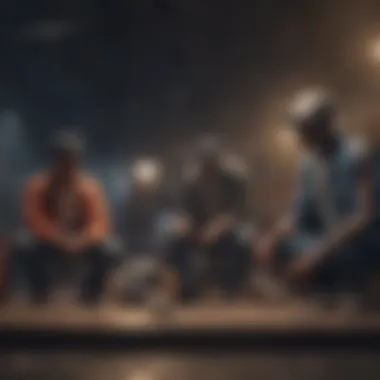
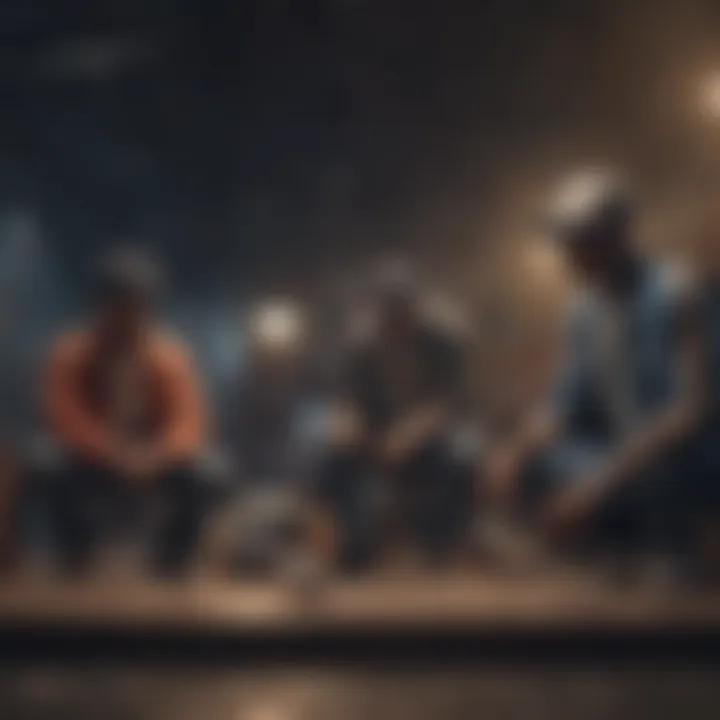
- Accessibility: Open mics welcome everyone and provide a platform for emerging talents.
- Community Building: These events foster connections among rap enthusiasts, artists, and producers.
- Skill Development: Rappers can practice and hone their style in a supportive setting.
Online Competitions
The rise of digital platforms transformed freestyle competitions by providing new avenues for participation. Online competitions democratize access to a global audience and allow artists from various backgrounds to compete. Websites and social media platforms host these contests, improving outreach and visibility for participating rappers. As a result, artists can gain recognition without geographic limitations.
Several benefits of online competitions are:
- Wider Reach: Participants can connect with an audience worldwide and collaborate across borders.
- Diverse Formats: Various online formats can accommodate different styles, including video submissions and live-streamed battles.
- Feedback and Engagement: Viewers can engage directly with artists through comments and shares, creating a dialogue around performances.
Online platforms are redefining traditional performance spaces, enabling artists to reach new fans.
Through both open mic events and online competitions, freestyle rap continues to evolve. These platforms not only nurture talent but also stimulate creativity and collaboration, essential components of the freestyle rap ecosystem.
Case Studies of Successful Freestylers
This section examines significant case studies of successful freestylers, providing insights into their performances and artistic journeys. Understanding these case studies is vital because they illustrate how individuals navigate the freestyle rap scene, enhancing our comprehension of the genre's dynamics.
Analysis of Key Performances
Key performances often showcase the essence of freestyle rap. These moments allow artists to demonstrate their skills, creativity, and ability to engage with the audience. Analyzing these performances reveals several crucial elements:
- Technique: The way an artist handles rhythm, flow, and delivery can set them apart from their peers. A standout performance often highlights the artist's unique style.
- Content: The ability to create relevant, catchy, and thought-provoking lyrics spontaneously is fundamental. Successful freestylers often weave topical references into their music, resonating with the audience.
- Emotion: The emotional delivery of lyrics greatly impacts how the audience perceives the performance. Artists who convey raw feelings often create lasting impressions.
For example, during a national competition, an artist might tackle societal issues subtly while maintaining an engaging flow. This not only showcases their skill but also demonstrates the genre's deep cultural connection.
"Freestyle rap is not just about words; it's about communicating emotions and ideas in a captivating manner."
Study of Influential Freestyle Artists
Influential freestyle artists have paved the way for many aspiring musicians in the genre. Their contributions extend beyond performances; they shape the culture and set trends. Among notable figures are:
- Eminem: Known for his intricate rhyme schemes and narrative style, Eminem’s battles and performances have inspired countless artists. His rapid delivery and ability to address personal themes have made him a pivotal figure.
- Black Thought from The Roots: Frequently praised for his lyrical depth and improvisational prowess, Black Thought demonstrates the importance of authenticity in freestyle rap. His live performances often elicit admiration and respect from both peers and fans alike.
- KRS-One: This artist’s impact on the hip-hop scene is profound. His freestyles often incorporate social commentary and educational themes, pushing the boundaries of what rap can convey.
These artists not only excel in their craft but also influence future generations by demonstrating the potential of freestyle rap as a serious art form. Aspiring musicians can learn a great deal by studying their methods and performances, absorbing techniques that they can adapt to their unique styles.
Future Trends in Freestyle Rap Instrumental Beats
The landscape of freestyle rap instrumental beats is constantly evolving. As technology advances, new production techniques and shifts in audience preferences begin to shape the genre. This section explores the emerging trends defining the future of freestyle rap and their significance for artists and listeners alike.
Innovations in Beat Production
In recent years, we have witnessed significant innovations in the way beats are produced for freestyle rap. The emergence of AI and machine learning tools is revolutionizing the creative process. These technologies allow producers to generate unique sounds and compositions with unprecedented speed and accuracy. New software, such as Ableton Live and FL Studio, includes features that enable musicians to create complex rhythms and layers effortlessly.
Furthermore, sampling, once a labor-intensive task, has become more accessible. Tools like Splice offer vast libraries of samples that artists can manipulate and combine. This ease of access propels creativity, letting artists experiment without a steep learning curve.
Additionally, mobile applications for beat making have democratized music production. Apps such as GarageBand allow aspiring musicians to create instrumentals from their smartphones. This trend will likely continue, as more individuals discover and share their talent, contributing to the rich tapestry of freestyle rap.
Shifting Audiences and Streams
The audiences for freestyle rap instrumental beats are also shifting. Streaming platforms like Spotify and Apple Music have changed how music is consumed, providing wider access to diverse styles and artists. This accessibility has led to the rise of niche genres and subcultures within the freestyle rap community. Artists now have the ability to cater to specific demographics, enabling them to build loyal followings.
Social media platforms, especially TikTok and Instagram, play a significant role in shaping audience preferences. Trends can explode overnight, leading to increased interest in certain styles and producers. As a result, artists need to stay responsive to these trends and adapt their work accordingly.
The blending of different musical influences is becoming increasingly common. This cross-pollination results in hybrid styles, attracting listeners from various genres. This diversification leads to a richer listening experience and encourages collaborations between artists from varied backgrounds, ultimately enriching the freestyle rap scene.
The evolving artistry of freestyle rap showcases the impact of technology and audience behavior on music production.
In summary, the future of freestyle rap instrumental beats appears bright. Innovations in production and the shifting landscape of audiences blend to create a dynamic environment. As these trends continue to unfold, they will likely reshape the genre’s soundscape while fostering collaboration and creativity.
Freestyle Rap and Collaboration
Collaboration in freestyle rap is a critical element that enhances both the creativity and the reach of artists. It introduces diverse perspectives and styles that enrich the overall quality of performances. When artists collaborate, they transcend their individual abilities, creating a synergistic effect that can lead to impressive results. The dynamic nature of freestyle rap encourages these partnerships, making it a vibrant aspect of the genre.
Networking Within the Industry
Networking plays a vital role in the success of freestyle rappers. It allows artists to make connections with producers, fellow musicians, and influencers. These relationships can lead to opportunities for collaboration, performance gigs, and shared resources. A thoughtful approach to networking can yield significant benefits.
- Building Relationships: Attending events, local open mics, or industry conferences can help artists meet others in their field.
- Collaboration Opportunities: Artists can team up, mixing different styles and influences, resulting in innovative beats and lyrics.
- Resource Sharing: Connecting with established musicians can provide valuable insights, tips, and tools that help improve skills.
Artists should focus on actively engaging with their peers and staying present in the community. Through social media platforms like Facebook and Reddit, they can showcase their work and reach wider audiences.
Collaborative Projects and Performances
Collaborative projects and performances are where the magic often happens in freestyle rap. These moments can lead to remarkable creativity, where individual artists blend their distinctive elements to create something new.
In a collaborative project, the process may vary:
- Feature Tracks: One artist may invite another to contribute verses, enhancing tracks with varied lyrical styles.
- Cyphers: Groups of rappers come together and share their verses in an informal setting. This can be a great way to showcase talent.
- Battles: Friendly competitions where artists perform against each other, fostering improvement through challenges.
"Collaboration not only builds the music but also creates a sense of community among artists."
Collaborative performances, in particular, allow artists to leverage each other's strengths on stage. These instances often captivate audiences, providing a richer experience than solo acts can offer. Establishing collaborative connections is essential for freestyle rappers, as it cultivates an environment where creativity can thrive.
Culmination
The conclusion of our exploration into freestyle rap instrumental beats underscores their significance in music and cultural expression. As we reflect on the various aspects discussed throughout the article, it becomes evident that these beats play a pivotal role in shaping both the art form and the community surrounding it.
Reflections on Freestyle Rap
Freestyle rap is not just about lyricism; it is also about spontaneity, creativity, and interaction. When artists engage with instrumental beats, they create a dynamic environment that encourages improvisation and self-expression. This art form challenges artists to think on their feet, translating emotions and experiences into articulate rhyme.
The best freestylers are adept at weaving narratives and showcasing their individuality. Their performances are a direct reflection of their connection to the instrumental sounds behind them. In essence, freestyle rap serves as a conduit for personal storytelling, allowing artists to connect deeply with audiences. Moreover, the space for diverse voices is critical, fostering a culture of inclusivity and unity through music.
The Ongoing Evolution of Instrumental Beats
The landscape of instrumental beats is continually morphing. With the advancement of technology, producers have access to an array of tools that allow for unprecedented creativity. Digital audio workstations are now the norm, enabling musicians to experiment with sounds and styles in ways previously unimaginable. The evolution of sampling and remixing has also reshaped the sonic palette available to artists.
Innovation is a driving force in the production of freestyle beats. As artists seek to differentiate their sound, they often explore new genres and cultural influences. This blending of styles leads to hybrid beats, captivating a broader audience and introducing unique elements into the freestyle rap scene.
In summary, understanding the significance of freestyle rap instrumental beats reveals not only their artistic importance but also their influence on community and culture. They are a testament to the versatility and adaptability of rap as a genre, enabling artists to push boundaries and redefine conventional expressions of music.







